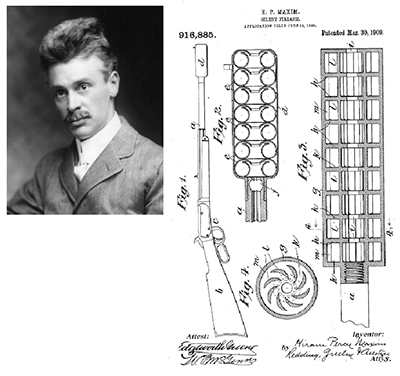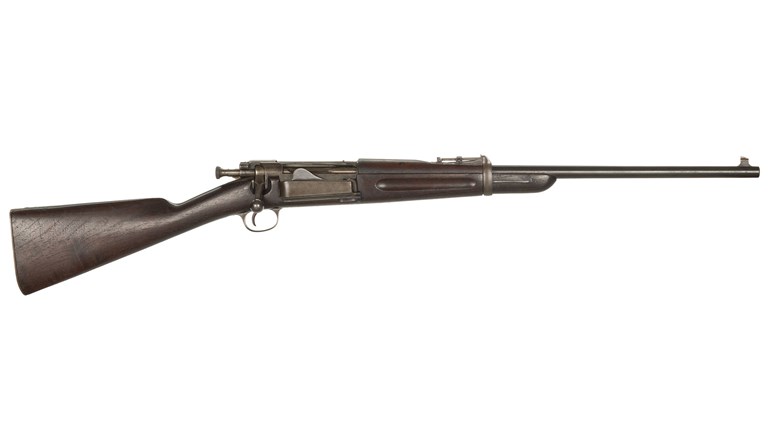
The men whose names are common amongst firearm enthusiasts often made their marks in other fields of endeavor far outside the world of guns. Samuel Colt invented a marine torpedo, as did Arthur Savage, who also invented radial tires. L.C. Smith not only gave his name to a fine line of shotguns, but also revolutionized the typewriter industry. Sir Hiram Stevens Maxim is well-known as the father of the machine gun, but he also can lay claim to an electric light bulb and numerous other non-ballistic inventions. His son, not as well known, was also a gifted inventor, whose inventions have been responsible for otolaryngologists (ENTs) not being overwhelmed with clients.
As we look back at the past 150 years of NRA history, one of my favorite stories concerns the staff of the NRA during the last century. Led and staffed by former military officers since its incorporation, NRA was sometimes jokingly referred to as National Retired Army. When someone cupped their hand and placed it behind their ear and said “eh?” that was known as the NRA salute. Things would be a lot worse for all of us, shooters and non-shooters alike, if it weren’t for the inventive genius of Sir Hiram Maxim’s son, Hiram Percy Maxim. Percy Maxim not only invented the first firearm suppressor in 1902, but is also responsible for developing the suppressor for use in his first love, the automobile. The now-standard automobile muffler is his gift to history and the peace and quiet of our highways and byways.
The Maxim Silencer, as it was known and marketed, was used on firearms in an effort to limit not only hearing loss, but also social disturbances near ranges and hunting grounds. It proved instantly popular and had patrons such as President Theodore Roosevelt, who had one mounted on the end of his Winchester Model 1894 rifle. He said he was fond of using the silencer while he was ridding his estate, Sagamore Hill, of varmints during his early-morning rides around the North Shore of Long Island, NY. He thought it best not to wake the neighbors with sporadic gunfire in the wee hours, especially when the neighbors bore the last names of Whitney, Vanderbilt and other scions of New York’s elite.

From their inception, until World War II, the chief use of Maxim’s invention was to enjoy hunting and shooting without the abundance of noise that most firearms produced. During the era of blackpowder, guns made plenty of noise, but anyone who has been near the firing line at an event of the North-South Skirmish Association will tell you, even thousands of muzzle-loading rifles, firing .58-caliber Minié balls sounds more like a massive popcorn machine than the noises we are used to hearing at our favorite shooting range on a Saturday afternoon.
The advent of smokeless powder cartridges in the late 19th century brought a new host of innovations to the firearms world. The reduction of powder fouling made the development of Sir Hiram’s machine gun possible, but it also brought about an increase in decibels when the new, aerodynamic spitzer rounds exceeded 1,100 fps, breaking the sound barrier. The sonic crack greatly increased the noise that the shooter experienced, and hearing protection was seldom utilized. Ask any artillerist who served during or before the Vietnam era, but make sure you speak up and in a loud and clear voice.
Allied special forces in World War II found a use for silencers for their clandestine raids behind enemy lines. Crossbows and CO2 dart guns had been in use, but the need for something more lethal was desired, and by early 1942, the Office of Strategic Services (OSS) was developing .22-caliber Colt Woodsman and High Standard HD pistols with Maxim silencers. In early 1944, the OSS ordered 1,500 High Standard HDM pistols fitted with suppressors for use in both theaters of operations.
The British SOE (Special Operations Executive) also fielded its .32-caliber Welrod pistol, which had an integral silencer built into it. Our U.S. Navy ordered and built nearly 1,000 Welrods before the High Standard pistol was available. M3 grease guns and even M1 carbines were fitted with silencers, but never in great numbers.
The main function of a suppressor is to reduce the audible noise made by the escaping gasses from the fired cartridge. A series of baffles in the tube are used to redirect the powder blast (ballistic noise) and slow it down as it exits the muzzle. If you can effectively accomplish reducing the ballistic noise, you can operate a small-caliber firearm without attracting much attention. Most standard-velocity, .22-caliber rounds are travelling at speeds less than 1,100 fps, making them subsonic, ideal for a “silenced” gun.
Anyone who has fired a pneumatic cane gun—or even something as historic as the Lewis & Clark .46-caliber Girandoni air rifle—will tell you that even air rifles are not really silent. The key to keeping the round somewhat quiet is keeping the action closed (semi-autos work best) and firing subsonic rounds. Of course, the National Firearms Act (NFA) of 1934 placed civilian ownership of silencers, along with machine guns, short-barreled rifles and shotguns, into the hands of only those who could pay the $200 tax, which placed them out of the reach of most shooters at the time.
Movies and television shows in the post-war era were full of secret agents and wet-work operatives who handled a suppressed handgun with great dexterity and in so doing, never woke the sentries, or in 007’s case, the girl in bed next to him at the time. Real life is much different. Revolvers, with the exception of the Model 1895 Nagant, are poor subjects for suppressors. The gap between the cylinder and barrel will allow too much noise to escape.
Currently, the U.S. Marine Corps has begun to field test and issue suppressors for combat use on a standard basis. Previously, these had been used in Iraq and Afghanistan by select snipers. Soon, a suppressor on a Soldier’s rifle could be as common as bayonets were during the Civil War.
Ask about suppressors, and many don’t realize how popular, useful and important they are. Currently, silencers are legal to own in 42 states—and you can hunt with them in 40 states. The NRA has been tirelessly working on making legislative and regulatory changes so more folks can use them, as the benefits to prevent hearing loss are abundant and obvious. Further, they create a more pleasant environment in areas where urban sprawl has begun to edge out open ranges. Many resources are available to assist consumers with navigating the NFA-approval process. Try a suppressor out, and you’ll want one yourself.





































